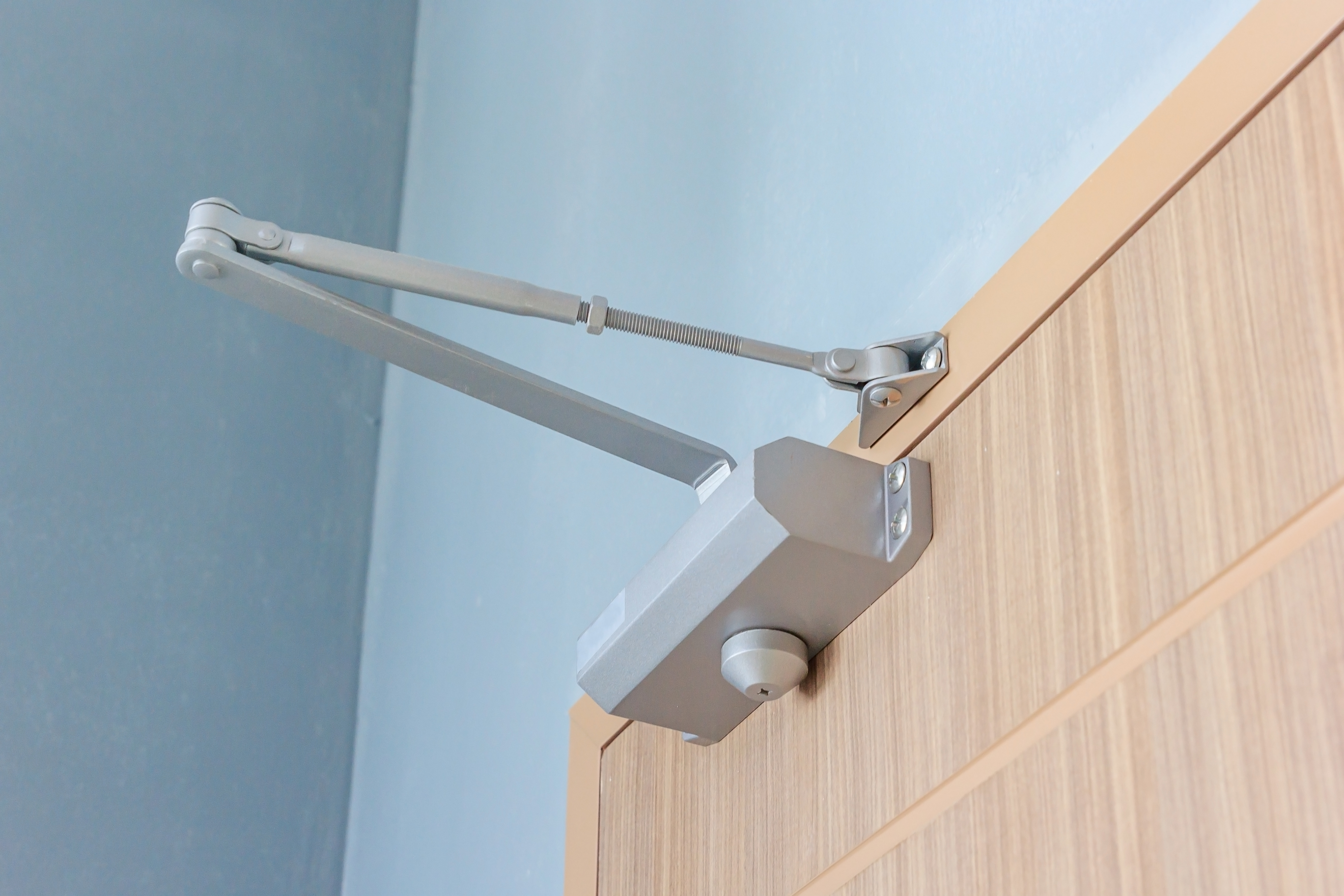How To Adjust Self-Closing Fire Door Hinges | Step-By-Step Guide

Fire doors are an essential passive safety feature. But to work effectively, they need the correct components. Here, we’ll explore the importance of self-closing fire door hinges and how to adjust them.
Importance of Properly Adjusted Fire Door Hinges
A fire door can only work correctly if it fits properly and can close fully. Fire door hinges play a crucial role in this.
In a fire, the fire door needs to open correctly to allow occupants to escape. It’s equally important for the door to automatically close afterwards. Fire safety door hinges make this possible. But they’ll only perform this function if they are fitted correctly.
What are self-closing fire door hinges? Fire door hinges are always made from metals with a melting point that’s above 800 degrees. This ensures that the hinges don’t warp or melt from the fire’s extreme temperatures. These strong hinges hold the door in place, ensuring it doesn’t drop or come loose. This helps to keep the door sealed and prevents fire and smoke from travelling through it. If the fire door hinges aren’t properly adjusted they cannot hold the fire door in place. The fire doors will also close at the wrong speed. This makes adjusting fire door hinges an essential fire door maintenance task.
Types of Self-Closing Hinges for Fire Doors
When it comes to self-closing hinges for fire doors, there are a couple of options to choose from.
Ball-Bearing Fire Door Hinges
Ball-bearing fire door hinges are among the most popular fire door hinges used. As their name suggests, ball-bearing hinges contain small metal balls. These balls sit inside the hinge and reduce friction.
Lift-Off Fire Door Hinges
Lift-off fire door hinges are hinges that allow the door to be lifted off without the hinges being removed. These are rarely used on fire doors as ball-bearing hinges are the preferred choice.
Step-By-Step Guide to Adjusting Self-Closing Hinges
Regularly inspecting every part of a fire safety door is something that should be done regularly. If you notice issues relating to how the door is hanging or how it opens and closes, the hinges could be the problem.
The more often the door is used, the more likely you will need to adjust the hinges. Wear and tear can cause the hinges to loosen. You may also notice that the door starts to open and close too quickly, or doesn’t close fast enough. These issues can all be fixed with a few adjustments.
Here’s how to adjust self-closing fire safety door hinges:
Tools
To adjust self-closing hinges you will need:
- Spirit level
- Screws
- Screwdriver
- Allen key
- Pliers
Adjusting the Self-Closing Hinges
- Start by inserting the Allen key into the top of the hinge. Rotate the Allen key clockwise if your door opens from right to left. Or, rotate the Allen key anti-clockwise if your door opens from left to right.
- The pin will then loosen and can be removed with the pliers.
- Turn your Allen key until a hole comes into view.
- Now insert your pin in the hole and test the door.
- If you’re not happy with the closing speed of the door, turn the Allen key once more and insert the pin in the next hole.
- Repeat this until you’ve reached the perfect closing speed.
If you notice that the screws in your hinges are coming loose, you will need to tighten these using a screwdriver. It’s so important that fire doors sit flush in the frame. This means it’s best to use a spirit level to check that the door is hanging level once you’ve tightened the screws. To ensure the hinges are fire-resistant, you must only ever use the screws supplied with your fire-door hinges.
Trouble-Shooting Common Issues
A few common issues can affect your self-closing fire door hinges. Here’s how you can fix them:
Door Not Hanging Flush
A screw may have come loose on the hinge and may need tightening.
Door Closing Too Slow or Fast
Re-insert the Allen key into the hinge and try turning it once more. Test the door and repeat this process until you’re happy with the closing speed.
Hinge Shows Signs of Wear
Dark marks on the knuckle of the hinge suggest it’s showing signs of wear. Having the hinge replaced with a suitable fire door hinge by a competent person is essential.
Different Finishes.
When we dive into the world of self-closing fire door hinges, it's not just about their functionality and safety features; the finish on these little heroes plays a massive role too. Yep, you read that right! The finish on a fire door hinge is not just about making it look pretty (although that's a nice bonus); it's also about protection, durability, and matching the aesthetic of the door and the overall interior design.
Why the Finish Matters
Aesthetic Appeal: Let's face it, no one wants their sleek and stylish doors paired with hinges that look like they've been borrowed from Frankenstein's laboratory. The finish on these hinges ensures they complement your door's design, blending seamlessly or standing out as a statement piece, depending on what you're going for.
Consistency in Design: For the design enthusiasts out there, consistency is key. The right finish on your fire door hinges can tie together the look of a room or an entire building. Whether you're aiming for a modern, minimalist vibe or a more traditional, ornate look, there's a finish out there that fits perfectly.
The Most Popular Finishes
Stainless Steel: The MVP of hinge finishes, stainless steel is all about that sleek, modern look while offering excellent resistance to corrosion. It's like the Superman of finishes - strong, reliable, and looks good in any setting.
Polished Brass: For those looking to add a touch of elegance and warmth to their doors, polished brass is the way to go. It's perfect for traditional settings or adding a bit of vintage charm to modern interiors. Just keep in mind, it might need a bit more love and care to keep it looking its best.
Satin Chrome: If you're all about that subtle sophistication, satin chrome has got your back. It's less shiny than polished finishes, giving your hinges a muted, classy look while still offering excellent protection and durability.
Antique Brass: Want to add some old-world charm to your doors? Antique brass is your finish. It's perfect for adding character to traditional or rustic settings and is pretty darn resilient too.
Black Matt: For a bold, contemporary look, black matt finishes are increasingly popular. They're great for making a statement and can add a modern edge to any door. Plus, they're pretty good at hiding fingerprints and smudges, which is always a bonus.
Choosing the Right Finish
Picking the right finish for your self-closing fire door hinges comes down to a balance of functionality, durability, and aesthetics. Consider the environment where the hinges will be used, the overall design theme of the space, and how much maintenance you're willing to commit to.
By choosing the right finish, not only do you ensure the longevity and effectiveness of your fire doors, but you also add that extra layer of design cohesion to your space. After all, who says fire safety can't be stylish?
Conclusion
Self-closing fire door hinges are a key component of a self-closing fire door. Ensuring that the correct fire door hinges are used is vital for the fire door to work correctly. Regular safety inspections of the hinges are essential to keep them in working order.
Adjusting the hinges as needed so that the door closes correctly and at the right speed plays a crucial role in the functioning of a fire door. With regular fire door maintenance checks, your fire door hinges will help to keep your building safe for many years to come.


